Mysteries that require a grand reveal can go two ways in the art world. On the one hand we have the Sherlock Holmes equivalent, where an art puzzle is solved once we’re given a few extra-textual details we’d never glean from the information presented. I usually consider this approach to art making dickish because it leaves the audience feeling disenfranchised. On the other, we have the Arrested Development equivalent, wherein the viewing doesn’t make sense until the audience has seen the bulk of the show. Once that happens, a viewer can take great pleasure in details that once seemed superfluous.
Sarah Sze’s teetering scaffolding made of sticks, ladders, tape, and other mass-produced ephemera at the United States Pavilion works a lot more like Arrested Development than Sherlock Holmes. The individual parts don’t amount to much until you decode the whole, and even then you can’t be sure your thoughts are anything more than theories.
My theory is this: The show is both a production-site and graveyard for the relics of an unnamed religion. Members of this cult worship reproduction technology and mass-produced items of any form. I like this theory because it reflects our contemporary experience. It’s also a hell of a lot more interesting than the concept description which attaches an enormous number of stale Biennale themes to Sze’s work: It engages the history of a building and the colonization of peripheral space. It seeks equilibrium in a chaotic contemporary world.
The unidentified cult themes that arise from this basic framework are vastly more specific than anything you’ll read in the release and quite frankly, everywhere.
Take the building’s front entrance, which is papered with booklets about the show arranged in a semi-circle. Most have rocks on top of them, giving the arrangement a feel of remnants from an unnamed ceremony. Overhead, a scaffolding made of sticks and ladders teeters, while several small fake boulders rest on top of the building. It’s unclear how or why they got there; we know as much about Sarah Sze’s sculptures as we do Stonehenge.
Once inside the building, viewers are thrown into this world without much warning. Sze doesn’t provide wall text. Luckily, our first clue to this mysterious cult hits the viewer in the first room; the sole sculpture we see resembles a religious icon, and recreates the front room’s floor compass pattern in black tape. At this point, though, there’s not enough information to draw any conclusions. The sculpture that sits above the tape is made of sticks and movable tables and resembles a Maker Faire booth.
Sze’s work is less functional than many of those science and engineering projects. A ball of grass explodes sticks in front of a 3-D line rendering of rectangles, but neither serve any intelligible purpose. Neither does the disco ball hanging from a tripod, or the paper ball that gently sways before a suite of landscape snapshots. The work is fastidious to the point of being fussy, and while a viewer gets a certain amount of satisfaction from looking at the forms, there’s not enough take away here. It’s simply a maze of disparate materials, arranged.
That problem occasionally rears its head in subsequent rooms, but to a lesser degree. One sculpture over, we see what appears to be an investigation of sand, circles, and architecture. Here Sze carved circles out of her desk, suspended and lit them. It looks like aliens landed and decided to perform a number of unintelligible experiments.
That quality of strangeness generally serves Sze well, but it’s not always enough to maintain the viewer’s extended interest. The centerpiece of the show, a roundish boulder at the front door, is wrapped in a print of an actual rock and feels otherworldly underneath the Pavilion’s skylight. In the context of a Biennale, though, that’s just the awe infused by standard exhibition design. It wasn’t until two rooms later that I recognized the object for what it was: a relic and vessel of worship from Sze’s studio of reproductions.
For that realization to form, I had to spend an enormous amount of time inspecting Sze’s elaborately arranged sculpture with a swinging pendulum and complete a walk-through of her studio/worship room. Laid out on workbenches pushed against the wall are a whole range of fake tools for fake creations: plasticine D-rings, nails, and even eraser shavings. The room is flanked by a wall of mirrors, which only further replicates the replicates.
While this seemingly endless echo chamber is presented as though its studio manager simply stepped out for lunch, the more religious aspects of the show feel as though they are already abandoned. No one is remaking or tinkering with the worship circles and but for the lone swinging pendulum they remain almost entirely static.
That quality imbues the work with a sense of past, even though its history isn’t much older than the time it takes to unravel the work. Perhaps that interpretation isn’t quite what Sze had in mind—I imagine the papering of the past to hold a little more significance to her than it does for me—but no matter. Either way, it’s a world that continually relives the present in the past, and that looks a lot like contemporary life.
- A fake boulder papered in a digital print out of a rock
- A reflection of myself in Sarah Sze’s final room in the US Pavilion
- A view of Sarah Sze at the US Pavilion
- Sarah Sze, Installation view, The US Pavilion at the Venice Biennale
- Sarah Sze, Installation view, The US Pavilion at the Venice Biennale
- Sarah Sze. Images arranged by color.
- The final room in Sarah Sze installation
- The worship pit
- The worship pit

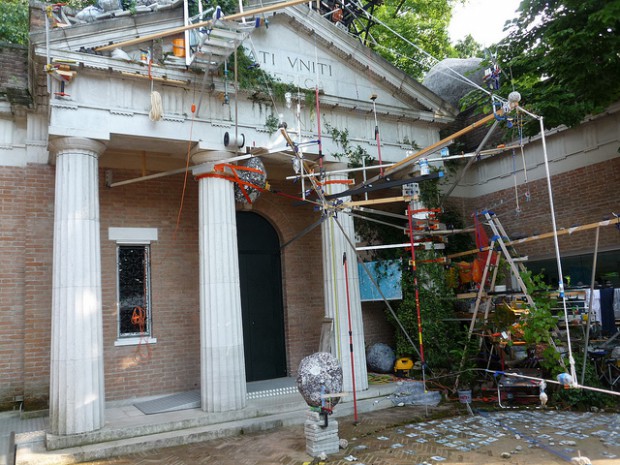
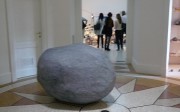



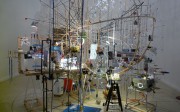
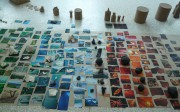

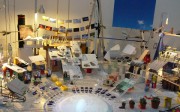
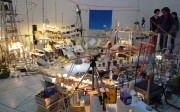

Comments on this entry are closed.